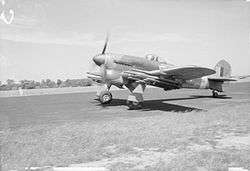No. 164 Squadron RAF
| No. 164 Squadron RAF | |
|---|---|
|
Typhoon of No.164 Squadron take off from RAF Thorney Island. | |
| Active |
June 1, 1918-July 4,1918 April 6, 1942-august 31, 1946 |
| Country |
|
| Branch |
|
| Type | Inactive |
| Role | Fighter Squadron |
| Motto(s) | '"Firmes volamos" (Firmly we fly) |
| Aircraft | Spitfire, Hurricane, Typhoon |
| Insignia | |
| Squadron Badge heraldry | In front of the rising sun a lion passant guardant |
| Squadron code | FJ |
No. 164 Squadron of the Royal Air Force was a fighter squadron during the Second World War composed of Argentine volunteers.
Background
No. 164 Squadron RAF was originally founded on 1 June 1918, but never received aircraft and was disbanded on 4 July 1918. The squadron was reformed at Peterhead, Aberdeenshire, on 6 April 1942, as a fighter squadron initially equipped with Spitfire Mk VAs, becoming operational in early May.
Around 600 Argentine volunteers, mostly of Anglo-Argentine descent, joined the British and Canadian Air Forces, many in the 164 Argentine-British RAF squadron, which motto was Firmes volamos (Determined We Fly) and its insignia was a British lion in front of a rising sun representing Argentina. Some pilots adorned the side of their aircraft with a picture of a popular Argentine cartoon character called Patoruzú, an indigenous man with incredible strength.[1][2]
In January 1943 the squadron moved to South Wales to train as a ground-attack unit, where it was equipped with Hawker Hurricanes. Operations against enemy shipping and coastal targets began in June 1943. Squadron Leader Percy Beake was put in charge of the Squadron in May 1944.[3]
After providing support for the landing forces from southern England, using Hawker Typhoons, the squadron moved to France in July 1944. During the Battle of Normandy, No.164 used its rockets against enemy armour in the battle area and after the breakout moved forward through northern France and Belgium in support of the 21st Army Group.
The squadron was renumbered No. 63 Squadron RAF on 31 August 1946.
Service

| From | To | Aircraft |
|---|---|---|
| April 1942 | September 1942 | Supermarine Spitfire VA |
| September 1942 | February 1943 | Supermarine Spitfire VB |
| February 1943 | May 1943 | Hawker Hurricane IID |
| February 1943 | February 1944 | Hawker Hurricane IV |
| January 1944 | May 1945 | Hawker Typhoon IB |
| June 1945 | July 1946 | Supermarine Spitfire IX |
| July 1946 | August 1946 | Supermarine Spitfire LF XVIE |
See also
- List of World War I flying aces from Argentina
- List of World War II flying aces from Argentina
- List of Royal Air Force aircraft squadrons
- English settlement in Argentina
- Kenneth Charney
- Maureen Dunlop
References
- (English) Argentine pilots break silence over World War Two - Reuters
- (Spanish) Los argentinos que pelearon en la Segunda Guerra, Clarin, 07.08.2005 Interview to 4 surviving Anglo-argentinian volunteers (retrieved on 04-09-2008)
- (Spanish) Condecoran a aviadores argentinos que pelearon en la II Guerra para Gran Bretaña, Clarin, 08.04.2005 Report about the ceremony at St. Clement Danes church, remembering the Argentines (including approximately 600 pilots) that fought in World War II on the allied side (retrieved on 04-09-2008)
Further reading
- Meunier, Claudio; Garcia, Carlos A. (2005). Alas de Trueno. n/a, Buenos Aires.
- Meunier, Claudio (2007). Nacidos con Honor. Grupo Abierto, Buenos Aires.
External links
| Wikimedia Commons has media related to No. 164 Squadron RAF. |
- RAF site, 164 Sqn.
- “Thunder wings”, the story of Argentine RAF pilots - MercoPress, March 8th 2004 (accessed 2015-11-15)

